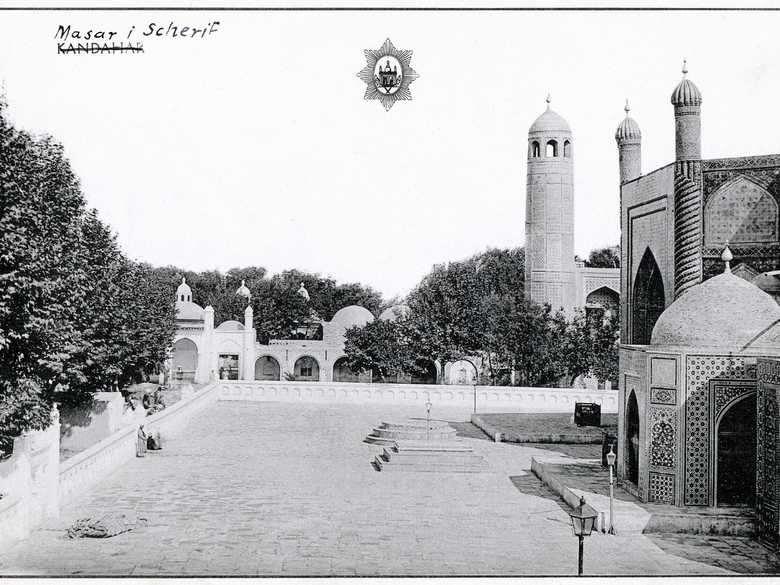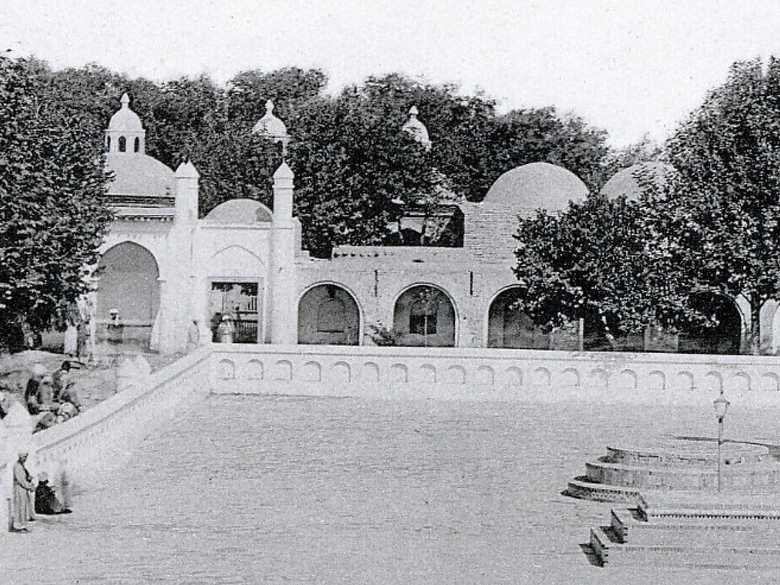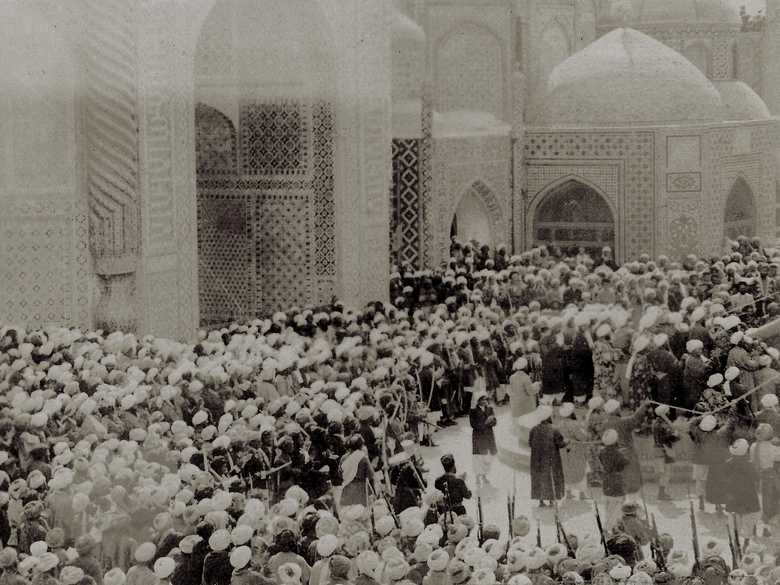SdA 3-178 — Mausolée de Hazrat Ali à Mazar-e Sharif
Vue dans la cour à l’ouest du mausolée de Hazrat Ali à Mazar-e Sharif. A l’arrière-plan un des minarets du portail nord. Derrière les arbres, l’ancienne bordure du sanctuaire (démoli en 1945) avec des cellules pour pèlerins et mourants. La petite structure à coupoles est un annexe du mausolée et contient la tombe de l’émir Sher Ali Khan (1822-1862-1879). Au premier-plan à droite, une autre chapelle, coupée par la prise, rectangulaire couronnée d’une coupole avec les tombeaux du Wazir Akbar Khan ...
Vue dans la cour à l’ouest du mausolée de Hazrat Ali à Mazar-e Sharif. A l’arrière-plan un des minarets du portail nord. Derrière les arbres, l’ancienne bordure du sanctuaire (démoli en 1945) avec des cellules pour pèlerins et mourants. La petite structure à coupoles est un annexe du mausolée et contient la tombe de l’émir Sher Ali Khan (1822-1862-1879). Au premier-plan à droite, une autre chapelle, coupée par la prise, rectangulaire couronnée d’une coupole avec les tombeaux du Wazir Akbar Khan et de quelques membres de la famille de l’émir Dost Muhammad (1792-1824-1840/1842-1862). Malgré la photo en noir et blanc, on voit très bien les façades décorées de carreaux de faïence. Dans la cour, on découvre également des réverbères. Dans l’ombre à droite de l’iwan ouest, une chaire en bois. Adossé au mur, à gauche, deux hommes et peut-être un enfant ; derrière eux, plus loin, d’autres personnes – tous portant des costumes traditionnels. Au premier plan, à gauche, devant un mihrab des tapis de prière. Au centre de la cour, deux plateformes. Chaque année à nowruz (nouvel an, le 21 mars) dans une grande cérémonie un mât est érigé sur la plateforme ronde.
KANDAHAR [sic!]
- Souvenir d’Afghanistan, série 1 (petit format) : n’y figure pas.
- Souvenir d'Afghanistan, série 2 (grand format), SdA 2-21 : identiques.
- Seraj ul-akhbar 5/18 (1916), p. 5 : photo identique.
- Sammlung Emil Rybitschka (1915) : ER 353 : photo de la cérémonie du 21 mars.
- Gray, J.A. (1895) : At the court of the Amir, p. 186 : «There is at Mazar-i-Sherif a great Mosque or Temple, from which the town takes its name. It is a huge ornate building with minarets, and a lofty cupola built of a shining blue stone. It is held in veneration by all Mussulmans, but more especially by the sect of Shiahs. The mosque contains a tomb which is supposed to be that of Ali, son-in-law of Mahomed, though some European authorities consider that Ali was buried near Baghdad. Be that as it may, the Mosque possesses considerable revenues, the gifts of wealthy votaries and other pious people, which are used to feed the crowds of indigent pilgrims who, at certain times in the year, flock in great numbers to Mazar. Moreover, the remains of Ali, or whoever the gentleman may be, are capable of working miracles of no mean order. […]» ; p. 302 : «They say it [the Mosque] is about two hundred years old. It is truly Oriental in style, with cupola, pierced stone (lattice work) windows, and minarets. The blue-stone – or porcelain – bricks of which it is built are of different tints, the contrasting tints being arranged in patterns. In the immediate grounds, or square, of the Temple, were kerchiefs, porcelain articles, and strings of beads, or rosaries. In the front of each shop was an awning of rush matting, supported on two poles.»
- Furon, R. (1926) : L’Afghanistan, f.p. 32 : photo identique, «Kandahar» [sic!].
- Adamec, L.W. (1975) : Who’s Who, pp. 133-134 : Dost Muhammad ; p. 243 : Sher Ali, Amir.
- Dupree, N.H. (1977) : An Historical Guide to Afghanistan, p. 392 : «[…] The tomb of Hazrat Ali lies within the inner chamber of the central shrine, covered with a richly embroidered cloth. The walls and ceiling of this room are profusely decorated, the artistry of Aslam Khan Kabuli and Adam Khan Ghaznavi who completed the work during the reign of Amir Sher Ali (1863-1879). Amir Sher Ali is buried outside the west door to the shrine. Just south of his tomb, there is a small chapel containing the tombs of several other members of Amir Dost Mohammad's family. The largest tomb of the group is that of another of the Amir's illustrious sons, Mohammad Akbar Khan who was buried here at his own request in 1843. […] In the courtyard, between the shrine and the mosque, note the square platform encircled with a wrought iron fence. […]»
- Adamec, L.W. (1979) : Mazar-i-Sharif and north-central Afghanistan, pp. 411-414 : Mazar-i-Sharif ; p. 411 : «The place is held sacred as the burial place of Ali, whose tomb consists of two lofty cupolas built by Sultan Ali Mirza in the first half of the fifteenth century.»
- Adamec, L.W. (1991) : Historical Dictionary of Afghanistan, p. 65 : Dost Muhammad, Amir ; pp. 218-219 : Shir Ali, Amir.
- Adamec, L.W. (2005) : Historical Dictionary of Afghan Wars, p. 105 : Dost Muhammad, Amir ; pp. 292-293 : Shir Ali, Amir.
Image No.
SdA 3-178
Collection
Souvenir d’Afghanistan 1925-1927
Series
SdA 3/5 (double face, 1927) 153 à 181 : Jalalabad, etc.
Format
image : 134/200 mmplanche :148/218 mmcouverture bleue ou verte
Quality
excellente ; noir et blanc
Place, date
Mazar-e Sharif, 191?
Descriptors
Latitude / Longitude36.708633 / 67.110623
Google Earth36°42’31'' N / 67°06’38'' E / 365 m
Google Mapshttps://maps.google.com
Zoom Earthhttps://zoom.earth
You know more about this picture?




